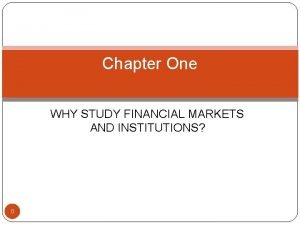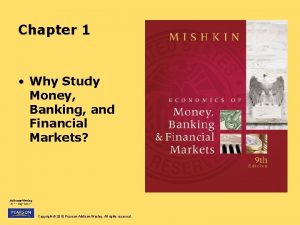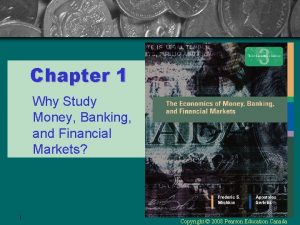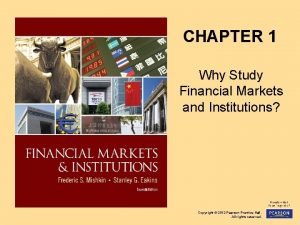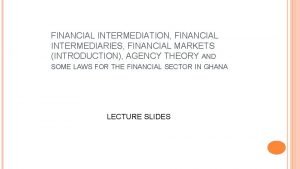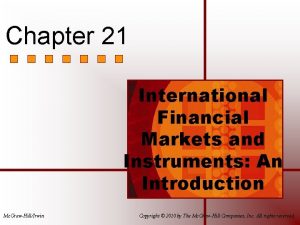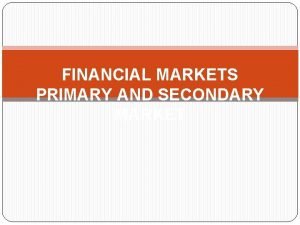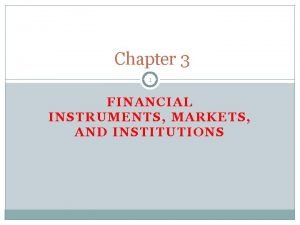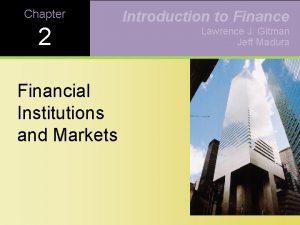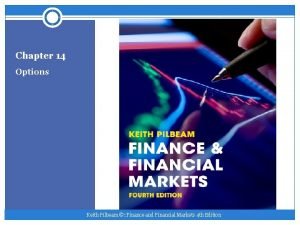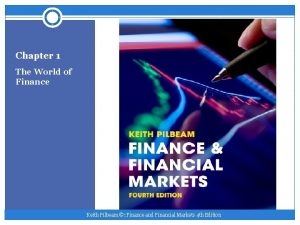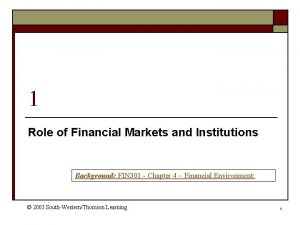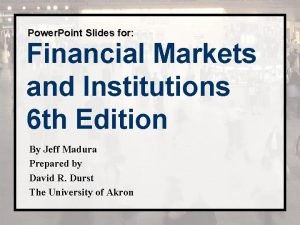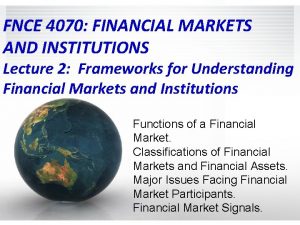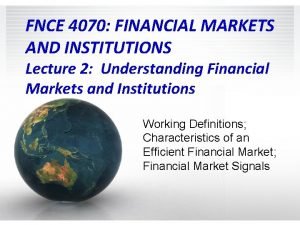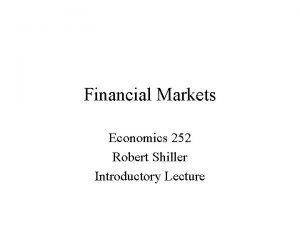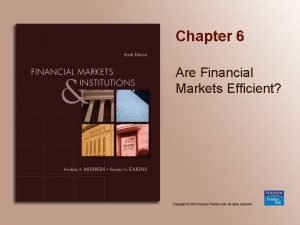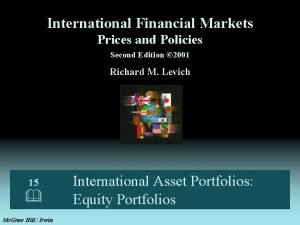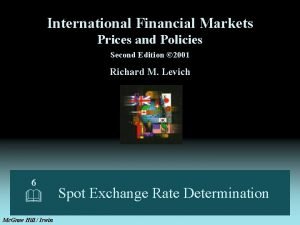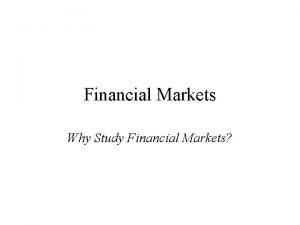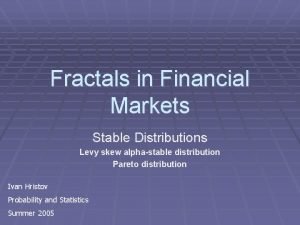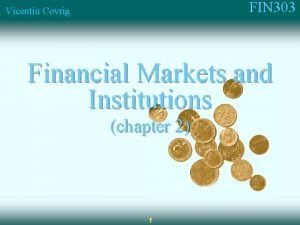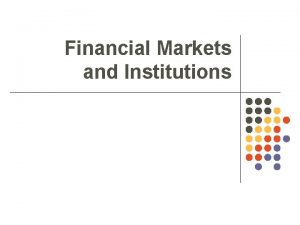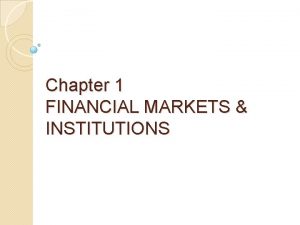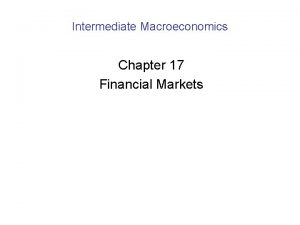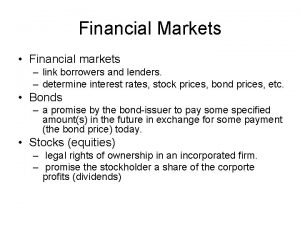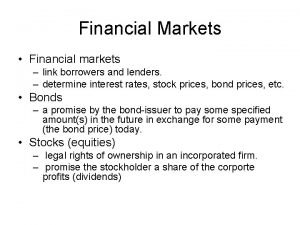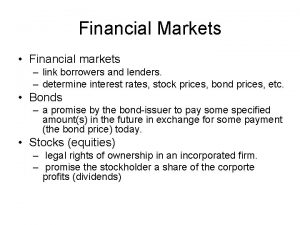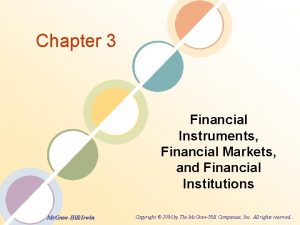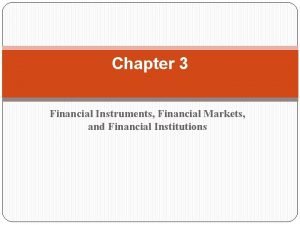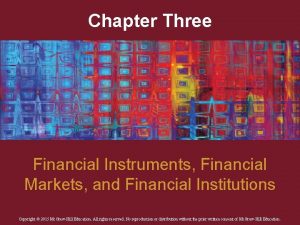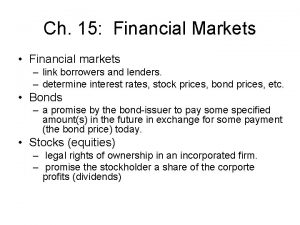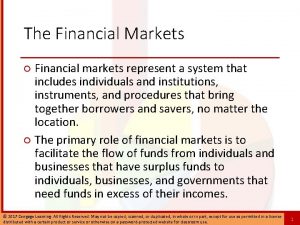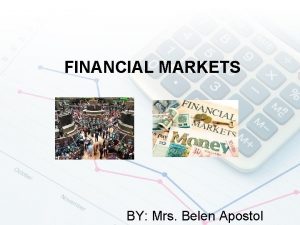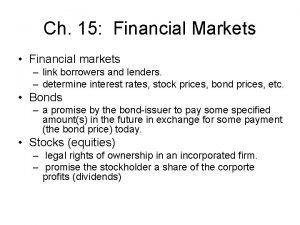Chapter One Introduction Why Study Financial Markets and



































- Slides: 35

Chapter One Introduction

Why Study Financial Markets and Institutions? l Markets and institutions are primary channels to allocate capital in our society l Proper capital allocation leads to growth in: l Societal wealth l Income l Economic opportunity © 2019 Mc. Graw-Hill Education. All rights reserved. Authorized only for instructor use in the classroom. No reproduction or further distribution permitted without the prior written consent of Mc. Graw-Hill Education.

Why Study Financial Markets and Institutions Continued…? l In this text we will examine: l l l the structure of domestic and international markets the flow of funds through domestic and international markets an overview of the strategies used to manage risks faced by investors and savers © 2019 Mc. Graw-Hill Education. All rights reserved. Authorized only for instructor use in the classroom. No reproduction or further distribution permitted without the prior written consent of Mc. Graw-Hill Education.

Financial Markets l l Financial markets are one type of structure through which funds flow Financial markets can be distinguished along two dimensions: l l primary versus secondary markets money versus capital markets © 2019 Mc. Graw-Hill Education. All rights reserved. Authorized only for instructor use in the classroom. No reproduction or further distribution permitted without the prior written consent of Mc. Graw-Hill Education.

Primary versus Secondary Markets l Primary markets l l Markets in which users of funds (e. g. , corporations) raise funds by issuing new financial instruments (e. g. , stocks and bonds) Secondary markets l Markets where existing financial instruments are traded among investors (e. g. , exchange traded: NYSE and over-the-counter: NASDAQ) © 2019 Mc. Graw-Hill Education. All rights reserved. Authorized only for instructor use in the classroom. No reproduction or further distribution permitted without the prior written consent of Mc. Graw-Hill Education.

Primary versus Secondary Markets Continued © 2019 Mc. Graw-Hill Education. All rights reserved. Authorized only for instructor use in the classroom. No reproduction or further distribution permitted without the prior written consent of Mc. Graw-Hill Education.

Primary versus Secondary Markets Concluded l How were primary markets affected by the financial crisis? l Do secondary markets add value to society or are they simply a legalized form of gambling? l How does the existence of secondary markets affect primary markets? © 2019 Mc. Graw-Hill Education. All rights reserved. Authorized only for instructor use in the classroom. No reproduction or further distribution permitted without the prior written consent of Mc. Graw-Hill Education.

Money versus Capital Markets Money markets l Markets that trade debt securities with maturities of one year or less (e. g. , CDs and U. S. Treasury bills) l l little or no risk of capital loss, but low return Capital markets l Markets that trade debt (bonds) and equity (stock) instruments with maturities of more than one year l substantial risk of capital loss, but higher promised return Figure 1. 3 l © 2019 Mc. Graw-Hill Education. All rights reserved. Authorized only for instructor use in the classroom. No reproduction or further distribution permitted without the prior written consent of Mc. Graw-Hill Education.

Money Market Instruments Outstanding, ($Tn) © 2019 Mc. Graw-Hill Education. All rights reserved. Authorized only for instructor use in the classroom. No reproduction or further distribution permitted without the prior written consent of Mc. Graw-Hill Education.

Capital Market Instruments Outstanding, ($Tn) © 2019 Mc. Graw-Hill Education. All rights reserved. Authorized only for instructor use in the classroom. No reproduction or further distribution permitted without the prior written consent of Mc. Graw-Hill Education.

Foreign Exchange (FX) Markets l FX markets l l Spot FX l l trading one currency for another (e. g. , dollar for yen) the immediate exchange of currencies at current exchange rates Forward FX l the exchange of currencies in the future on a specific date and at a pre-specified exchange rate © 2019 Mc. Graw-Hill Education. All rights reserved. Authorized only for instructor use in the classroom. No reproduction or further distribution permitted without the prior written consent of Mc. Graw-Hill Education.

Derivative Security Markets l Derivative security l A financial security whose payoff is linked to (i. e. , “derived” from) another, previously issued security such as a security traded in capital or foreign exchange markets l l Generally an agreement to exchange a standard quantity of assets at a set price on a specific date in the future The main purpose of the derivatives markets is to transfer risk between market participants © 2019 Mc. Graw-Hill Education. All rights reserved. Authorized only for instructor use in the classroom. No reproduction or further distribution permitted without the prior written consent of Mc. Graw-Hill Education.

Derivative Security Markets Continued l Selected examples of derivative securities l Exchange listed derivatives l l Many options, futures contracts Over the counter derivatives l l Forward contracts Forward rate agreements Swaps Securitized loans © 2019 Mc. Graw-Hill Education. All rights reserved. Authorized only for instructor use in the classroom. No reproduction or further distribution permitted without the prior written consent of Mc. Graw-Hill Education.

Derivatives and the Crisis 1. Mortgage derivatives allowed a larger amount of mortgage credit to be created in the mid-2000 s. l Growing importance of ‘shadow banking system’ 2. Mortgage derivatives spread the risk of mortgages to a broader base of investors. 3. Change in banking from ‘originate and hold’ loans to ‘originate and sell’ loans. l Decline in underwriting standards on loans © 2019 Mc. Graw-Hill Education. All rights reserved. Authorized only for instructor use in the classroom. No reproduction or further distribution permitted without the prior written consent of Mc. Graw-Hill Education.

Derivatives and the Crisis Continued 1. Subprime mortgage losses were large, reaching over $700 billion. 2. The “Great Recession” was the worst since the “Great Depression” of the 1930 s. l Trillions $ global wealth lost, peak to trough stock prices fell over 50% in the U. S. l Lingering high unemployment and below trend growth in the U. S. l Sovereign debt levels in developed economies reached post-war all-time highs © 2019 Mc. Graw-Hill Education. All rights reserved. Authorized only for instructor use in the classroom. No reproduction or further distribution permitted without the prior written consent of Mc. Graw-Hill Education.

Financial Market Regulation l The Securities Act of 1933 l l Full and fair disclosure and securities registration The Securities Exchange Act of 1934 l Securities and Exchange Commission (SEC) is the main regulator of securities markets © 2019 Mc. Graw-Hill Education. All rights reserved. Authorized only for instructor use in the classroom. No reproduction or further distribution permitted without the prior written consent of Mc. Graw-Hill Education.

Financial Institutions (FIs) l Financial Institutions l l Institutions through which suppliers channel money to users of funds Financial Institutions are distinguished by: l l Whether they accept insured deposits l Depository versus non-depository financial institutions Whether they receive contractual payments from customers © 2019 Mc. Graw-Hill Education. All rights reserved. Authorized only for instructor use in the classroom. No reproduction or further distribution permitted without the prior written consent of Mc. Graw-Hill Education.

Percentage Shares of Assets of Financial Institutions in the United States, 1948– 2016 © 2019 Mc. Graw-Hill Education. All rights reserved. Authorized only for instructor use in the classroom. No reproduction or further distribution permitted without the prior written consent of Mc. Graw-Hill Education.

Non-Intermediated (Direct) Flows of Funds Flow of Funds in a World without FIs Direct Financing Financial Claims (equity and debt instruments) Suppliers of Funds Users of Funds Cash © 2019 Mc. Graw-Hill Education. All rights reserved. Authorized only for instructor use in the classroom. No reproduction or further distribution permitted without the prior written consent of Mc. Graw-Hill Education.

Intermediated Flows of Funds Flow of Funds in a World with FIs Intermediated Financing FIs (brokers) Users of Funds Cash Suppliers of Funds FIs (asset transformers) Financial Claims (equity and debt securities) Cash Financial Claims (deposits and insurance policies) © 2019 Mc. Graw-Hill Education. All rights reserved. Authorized only for instructor use in the classroom. No reproduction or further distribution permitted without the prior written consent of Mc. Graw-Hill Education.

Depository versus Non-Depository FIs l Depository institutions: l l commercial banks, savings associations, savings banks, credit unions Non-depository institutions l l Contractual: l insurance companies, pension funds, Non-contractual: l securities firms and investment banks, mutual funds. © 2019 Mc. Graw-Hill Education. All rights reserved. Authorized only for instructor use in the classroom. No reproduction or further distribution permitted without the prior written consent of Mc. Graw-Hill Education.

FIs Benefit Suppliers of Funds l l l Reduce monitoring costs Increase liquidity and lower price risk Reduce transaction costs Provide maturity intermediation Provide denomination intermediation © 2019 Mc. Graw-Hill Education. All rights reserved. Authorized only for instructor use in the classroom. No reproduction or further distribution permitted without the prior written consent of Mc. Graw-Hill Education.

FIs Benefit the Overall Economy l l Conduit through which Federal Reserve conducts monetary policy Provides efficient credit allocation Provide for intergenerational wealth transfers Provide payment services © 2019 Mc. Graw-Hill Education. All rights reserved. Authorized only for instructor use in the classroom. No reproduction or further distribution permitted without the prior written consent of Mc. Graw-Hill Education.

Risks Faced by Financial Institutions l l l Credit Foreign exchange Country or sovereign Interest rate Market Volcker Rule: Insured institutions may not engage in proprietary trading l l l Off-balance-sheet Liquidity Technology Operational Insolvency © 2019 Mc. Graw-Hill Education. All rights reserved. Authorized only for instructor use in the classroom. No reproduction or further distribution permitted without the prior written consent of Mc. Graw-Hill Education.

Regulation of Financial Institutions l l l FIs are heavily regulated to protect society at large from market failures Regulations impose a burden on FIs; before the financial crisis, U. S. regulatory changes were deregulatory in nature Regulators attempt to maximize social welfare while minimizing the burden imposed by regulation © 2019 Mc. Graw-Hill Education. All rights reserved. Authorized only for instructor use in the classroom. No reproduction or further distribution permitted without the prior written consent of Mc. Graw-Hill Education.

Enterprise Risk Management l Enterprise risk management l l l Recognizes the importance of managing the combined impact of the full spectrum of risks as an interrelated risk portfolio Popularity rose as a result of the failure of advanced risk measurement and management systems to detect exposures that led to the financial crisis Stresses importance of building a strong risk culture © 2019 Mc. Graw-Hill Education. All rights reserved. Authorized only for instructor use in the classroom. No reproduction or further distribution permitted without the prior written consent of Mc. Graw-Hill Education.

Globalization of Financial Markets and Institutions l l The pool of savings from foreign investors is increasing and investors look to diversify globally now more than ever before Information on foreign markets and investments is becoming readily accessible and deregulation across the globe is allowing even greater access to foreign markets International mutual funds allow diversified foreign investment with low transactions costs Global capital flows are larger than ever © 2019 Mc. Graw-Hill Education. All rights reserved. Authorized only for instructor use in the classroom. No reproduction or further distribution permitted without the prior written consent of Mc. Graw-Hill Education.

Appendix: FIs and the Crisis Timeline of events l Home prices decline in late 2006 and early 2007 l Delinquencies on subprime mortgages increase l Huge losses on mortgage-backed securities (MBS) announced by institutions l Bear Stearns fails and is bought by J. P. Morgan Chase for $2 a share (deal had government backing) © 2019 Mc. Graw-Hill Education. All rights reserved. Authorized only for instructor use in the classroom. No reproduction or further distribution permitted without the prior written consent of Mc. Graw-Hill Education.

Appendix: FIs and the Crisis Continued Timeline of events l September 2008, the government seizes governmentsponsored mortgage agencies Fannie Mae and Freddie Mac l The two had $9 billion in losses in the second half 2007 l Now run by Federal Housing Finance Agency (FHFA) l September 2008, Lehman Brothers files for bankruptcy; Dow drops 500 points © 2019 Mc. Graw-Hill Education. All rights reserved. Authorized only for instructor use in the classroom. No reproduction or further distribution permitted without the prior written consent of Mc. Graw-Hill Education.

Appendix: FIs and the Crisis Concluded Figure 1 -9 The Dow Jones Industrial Average, October 2007–January 2010 © 2019 Mc. Graw-Hill Education. All rights reserved. Authorized only for instructor use in the classroom. No reproduction or further distribution permitted without the prior written consent of Mc. Graw-Hill Education.

Overnight LIBOR, 2001 - 2010 Figure 1 -10 Overnight London Interbank Offered Rate (LIBOR), 2001– 2010 © 2019 Mc. Graw-Hill Education. All rights reserved. Authorized only for instructor use in the classroom. No reproduction or further distribution permitted without the prior written consent of Mc. Graw-Hill Education.

Appendix: Government Rescue Plan Table 1 -12 Federal Government Rescue Efforts through December 2009

Appendix: Government Rescue Plan Continued Table 1 -12 Federal Government Rescue Efforts through December 2009

Federal Funds Rate and Discount Window Rate Figure 1 -11 Federal Funds Rate and Discount Window Rate—January 1971 through January 2010 © 2019 Mc. Graw-Hill Education. All rights reserved. Authorized only for instructor use in the classroom. No reproduction or further distribution permitted without the prior written consent of Mc. Graw-Hill Education.

Major Items in the Stimulus Program Table 1 -13 Major Items in the $787 Billion Stimulus Program as Passed by the U. S. Congress, February 13, 2009 © 2019 Mc. Graw-Hill Education. All rights reserved. Authorized only for instructor use in the classroom. No reproduction or further distribution permitted without the prior written consent of Mc. Graw-Hill Education.
 Why study financial institutions
Why study financial institutions Why study financial markets and institutions
Why study financial markets and institutions Why study money banking and financial markets
Why study money banking and financial markets Why study money banking and financial markets
Why study money banking and financial markets Why study financial markets
Why study financial markets Hey bye bye
Hey bye bye Financial intermediation ppt
Financial intermediation ppt Financial institutions and markets lecture notes ppt
Financial institutions and markets lecture notes ppt What is financial intermediation
What is financial intermediation International financial markets and instruments
International financial markets and instruments Capital markets and financial intermediation
Capital markets and financial intermediation How do primary and secondary financial markets differ
How do primary and secondary financial markets differ Efficient capital allocation
Efficient capital allocation Types of exchange rate
Types of exchange rate Financial markets instruments and institutions
Financial markets instruments and institutions Madura j. financial markets and institutions
Madura j. financial markets and institutions Pilbeam k. finance and financial markets
Pilbeam k. finance and financial markets Keith pilbeam
Keith pilbeam Functions of financial markets and institutions
Functions of financial markets and institutions Madura j. financial markets and institutions
Madura j. financial markets and institutions Savers and investors role in financial markets
Savers and investors role in financial markets Classification of financial markets
Classification of financial markets Financial market classification
Financial market classification Robert shiller financial markets
Robert shiller financial markets Classification of financial markets
Classification of financial markets Classification of financial markets
Classification of financial markets Are financial markets efficient
Are financial markets efficient Levich international financial markets
Levich international financial markets Levich international financial markets
Levich international financial markets Cisi financial markets
Cisi financial markets Classification of financial markets
Classification of financial markets Fractals in financial markets
Fractals in financial markets Well functioning financial markets
Well functioning financial markets Structure of twelfth night
Structure of twelfth night Why do markets exist?
Why do markets exist? Don't ask why why why
Don't ask why why why

